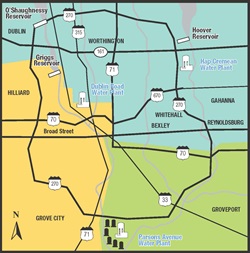Elevated Nitrate Levels
In the rare event the Columbus Division of Water notifies the public about elevated nitrate levels in drinking water, many customers want to know:
What causes elevated nitrate in drinking water?
 Nitrogen occurs naturally and is essential for plant growth. That is why it is applied as fertilizer to farmland, lawns, and golf courses. During certain weather conditions, especially after heavy rains, nitrate can run off into streams and rivers where it reacts with water to form nitrate.
Nitrogen occurs naturally and is essential for plant growth. That is why it is applied as fertilizer to farmland, lawns, and golf courses. During certain weather conditions, especially after heavy rains, nitrate can run off into streams and rivers where it reacts with water to form nitrate.
The Scioto River receives runoff from more than 1,000 square miles of land, 80% of which is agricultural, before reaching the Dublin Road Water Plant intake. Therefore, it is more susceptible to nitrogen runoff than the other water sources in Columbus.
How were acceptable nitrate levels established by EPA?
The acceptable level for nitrate in drinking water was established by the Environmental Protection Agency (EPA) as a safeguard to protect infants. Because of their immature digestive system, infants under six months of age cannot properly digest nitrates which interferes with the oxygen carrying capability of their blood. Therefore, the EPA established the "maximum contaminant level" for nitrate in drinking water at 10 milligrams per liter or 10 parts per million.
Who is affected . . . who is not?
Levels of nitrate in Columbus drinking water pose no threat to the majority of people. Only infants less than six months of age are affected when the level of nitrate is above the standard. Pregnant or nursing women, or anyone with medical conditions, should consult with their doctor about limiting nitrate consumption. Many vegetables and processed meats contain nitrates. Water is generally a minor source of nitrate in the diet.
Why and how is the public notified?
Water suppliers are required to notify the public when nitrate levels are more than 10 parts per million in the drinking water. On rare occasions, the water from the Dublin Road Water Plant exceeds this standard. The Columbus Division of Water's Water Quality Assurance Laboratory routinely tests surface water samples and determines when nitrate levels are rising.
A "Nitrate Advisory" is sent to newspapers, TV and radio stations and placed on the Public Utilities as the top feature and placed in our Document Library in the current year's "News Releases" section when the nitrate level exceeds 10 parts per million. Through the media, parents of infants are notified of the specific area impacted and are advised to buy bottled water for the baby's needs until the advisory is lifted.
Historically, only the Dublin Road plant has ever been affected by elevated levels of nitrate - an infrequent occurrence which tends to be limited to April through July. Water supplied to the rest of our system by the Parsons Avenue and the Hap Cremean water treatment plants does not experience elevated nitrate levels.
To reduce the health risk to infants the City of Columbus recently added a treatment process, called anion exchange, to the Dublin Road Water Plant to remove nitrate. Anion exchange works like a giant water softener and pulls nitrate from the water as it flows through a bed of resin beads. Extensive water quality testing in the watershed upstream of the water plant by the Water Quality Assurance Laboratory helps to determine when we need to turn on the anion exchange system. Then additional water quality testing of the finished drinking water confirms that the nitrate level has been reduced below 10 ppm and is safe for infants. With this added treatment system in place, elevated nitrate is expected to be a thing of the past.
 The Dublin Road Water Treatment Plant supplies water to:
The Dublin Road Water Treatment Plant supplies water to:
- Downtown Columbus
- Upper Arlington
- Grandview
- Hilliard
- Marble Cliff
- German Village
- Grove City (portions)
- West Columbus
- SW Columbus (to Scioto River)
- Lincoln Village
To receive informative brochures regarding Columbus Drinking Water Quality, call our Customer Service Center at 614- 645-8276 (weekdays 7 am - 6 pm), email utilityleadrep@columbus.gov, or view the annual drinking water quality report. For specific questions, call the Water Quality Assurance Laboratory at 614-645-7691 (weekdays 8 am - 4 pm), or email: WaterQuality@columbus.gov.
Frequently Asked Questions
What causes elevated nitrate in drinking water?
Nitrogen occurs naturally and is essential for plant growth, which is why it is applied as fertilizer to farmland, lawns, and golf courses. During certain weather conditions, the fertilizer can run off into streams and rivers where it reacts with water to form nitrate.
The Scioto River receives runoff from more than 1,000 square miles of land, 80% of which is agricultural, before reaching the Dublin Road Water Plant intake. Therefore, the Scioto River is more susceptible to nitrogen runoff than the other water sources in Columbus.
How is the public notified of a nitrate alert?
Water suppliers are required by the OEPA to notify the public when nitrate levels are more than 10 parts per million in the drinking water. The Division of Water's Water Quality Assurance Laboratory monitors nitrate levels regularly. When the levels exceed the standards, news releases are provided to local television, radio and newspaper media outlets. Advisories are also posted on the city's web site at: Public Utilities as the top feature and placed in our Document Library in the current year's "News Releases" section.
What does "parts per million" mean?
"Parts per million" (ppm) is a measure of the concentration of a substance (such as nitrate) in water. As an example, let's say a bucket of water has nitrate in it at a level of 10 parts per million (or mg/L). If the bucket of water had a million drops of water in it, 10 of those drops would be nitrate and the rest of the drops would be water. (Source: United States Environmental Protection Agency)
Who should be concerned?
When a nitrate advisory is in effect, customers in the Nitrate Advisory Area of that water plant are advised to not give tap water to infants below the age of six months or use it to make infant formula, juice, or baby cereal.
Until the advisory is lifted, bottled water should be used for infants below the age of six months. Do not boil the tap water; boiling increases nitrate levels in the tap water.
Healthy adults and older children can consume higher levels of nitrate because they have fully developed digestive systems. Nitrate is commonly consumed by older children and adults as it is contained in many foods such as processed meats and lettuce. Those who are pregnant, nursing or have any medical conditions should consult their doctor on nitrate concerns.
What are the possible health effects of nitrate?
Nitrate is considered a toxin to infants below the age of six months. Please see the fact sheet from the Ohio Environmental Protection Agency (OEPA) for more information.
Is it safe to bathe in water with elevated levels of nitrate?
Yes, it is safe for adults and infants to bathe in water that contains nitrate. Nitrate is only a concern for ingestion (eating and drinking). It is not absorbed through your skin. (Source: United States Environmental Protection Agency)
Can baby bottles be washed with tap water during a nitrate alert?
Yes, it is safe to wash baby bottles in tap water containing nitrate. Please remember to use bottled water for mixing any formula, juice, or cereal for infants under the age of six months.
Is elevated nitrate a concern for pets?
The water should be safe for consumption by household pets, including puppies, kittens and elderly pets, but if you have concerns, please contact your veterinarian. Pocket pets, because of their small size and many different intestinal considerations, should always be given bottled water. Neonatal calves and pigs are more susceptible to high concentrations of nitrates in the water.
How often are nitrate advisories issued in Columbus?
In June of 2016 and June of 2015 nitrate advisories were issued. In the fifteen years prior, nitrate levels exceeded standards on just two occasions, in 2000 and in 2006. The frequency is dependent upon a variety of factors including weather patterns.
How long do the advisories usually last?
The advisories can last from a few days to several weeks. They are lifted when the source nitrate levels return to normal.
What is the City of Columbus doing to prevent nitrate levels from rising?
The Department of Public Utilities is a partner in the Conservation Reserves Enhancement Program for agricultural landowners to encourage specific conservation practices.
The Division of Water's Watershed Management staff also works with property owners along the reservoirs to encourage environmental stewardship.
Additional efforts include recent installation of green infrastructure around Griggs, O'Shaughnessy and Hoover reservoirs to naturally filter stormwater that carries nitrates, and an upcoming comprehensive study of the Scioto River watershed to identify long-term nitrate reduction solutions.
Lastly, the Dublin Road plant completed a $200 million project to expand capacity and improve treatment to meet EPA regulations; this work included a $35 million ion exchange treatment facility which allows the plant to more effectively treat nitrate events such as this one.
How can I find out if I am in the affected service area?
Historically, only the Dublin Road plant has ever been affected by elevated levels of nitrate. It serves portions of west, central, and southwest Columbus, as well as Grandview Heights, Grove City, Hilliard, Lincoln Village, Marble Cliff, Upper Arlington, Urbancrest, and Valleyview.
If there is a nitrate event, you can check a map on our Website that will show any areas under a nitrate advisory. If you do not have Internet access, you can call our Customer Service Center at 614 645-8276 during regular business hours (weekdays 7AM - 6PM).
I use a carbon filter. Will this help?
Activated carbon filters, such as those in a "Brita" water pitcher, do not remove nitrates. (Source: United States Environmental Protection Agency)
What about home filter systems?
Point of use (POU) filter systems treat water at a single tap. Point of entry (POE) filter systems treat water used throughout the house. Two types of systems that will remove nitrates from your water are:
Reverse osmosis unit
Distillation unit
Important: All POU and POE filter systems or treatment units need maintenance to operate effectively. If they are not maintained properly, contaminants may accumulate in the units and make your water worse.
In addition, some vendors may make claims about their effectiveness that are not based on science. EPA does not test or certify treatment units, but two organizations that do are:
(Source: United States Environmental Protection Agency)